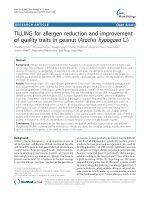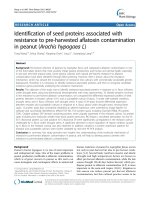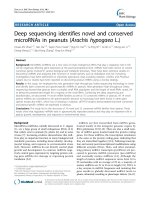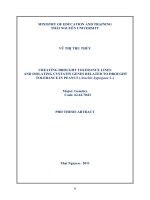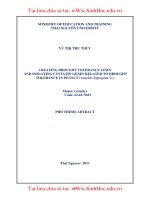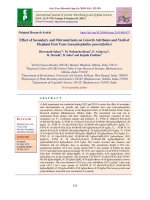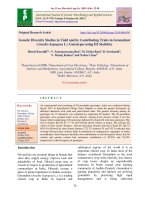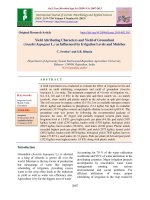Influence of secondary and micronutrients on yield and yield components in groundnut (Arachis hypogaea L.)
Bạn đang xem bản rút gọn của tài liệu. Xem và tải ngay bản đầy đủ của tài liệu tại đây (238.44 KB, 8 trang )
Int.J.Curr.Microbiol.App.Sci (2018) 7(9): 309-316
International Journal of Current Microbiology and Applied Sciences
ISSN: 2319-7706 Volume 7 Number 09 (2018)
Journal homepage:
Original Research Article
/>
Influence of Secondary and Micronutrients on Yield and Yield Components
in Groundnut (Arachis hypogaea L.)
G. Rajitha1*, M. Srinivasa Reddy1, P.V. Ramesh Babu1 and P. Uma Maheshwari2
1
Department of Agronomy, 2Department of Crop Physiology, Agricultural College,
Mahanandi-518502, ANGRAU, Andhra Pradesh, India
*Corresponding author
ABSTRACT
Keywords
Groundnut, Secondary
nutrients, Micronutrients,
Yield attributes, Yield
Article Info
Accepted:
04 August 2018
Available Online:
10 September 2018
Groundnut (Arachis hypogaea L.) is a major oilseed crop of our country and edible oil
economy primarily depends upon groundnut production. Intensive cropping leads to
deficiency of secondary and micronutrients, which is the main constraint for low yield of
groundnut. Field experiment was conducted at agricultural college farm, Mahanandi
during rabi season, 2015-16 to study the response of groundnut to secondary and
micronutrients. The results revealed that the highest pod yield was recorded in the
treatment with application of RDF + foliar application of one per cent each of CaNO3,
MgNO3 and sulphur + micronutrient mixture @ 0.2 per cent (T 10) (2654 kg ha-1) and it was
significantly superior over control (T 1) (1118 kg ha-1). All other yield components were
also significantly higher over recommended dose of fertilizer and control.
Introduction
Groundnut (Arachis hypogaea
L.) the
unpredictable legume is considered as heavy
feeder of nutrients. The productivity of
Andhra Pradesh (890 kg ha-1) is much lower
compared to national average (1750 kg ha-1)
(INDIASTAT, 2015). There are several
production constraints which could be
attributed to lower productivity. Mainly the
crop is grown on low fertility marginal lands
with low input supply and rainfed conditions.
The productivity enhancement target is still
elusive. With limited scope of bringing
additional area under oilseeds, bulk of the
future increase in production has to come
through crop nutrition. Therefore, it is most
essential to pay a great attention to the
nutrition of the groundnut to enhance its
productivity. Intensification of agriculture,
usage of straight fertilizers, rising crop
requirements due to increasing productivity
levels have heightened the secondary and
micronutrients demand in soil fertility
management and are increasingly becoming
major constraints to achieve augmented
agricultural production.
Among the oilseed crops, groundnut responds
well to secondary and micronutrient
309
Int.J.Curr.Microbiol.App.Sci (2018) 7(9): 309-316
fertilization. Depletion of secondary and
micronutrients necessitates periodic or yearly
supply of these nutrients. Further, we should
replenish secondary and micronutrients
appropriately because their dearth can hinder
groundnut response to major nutrients,
irrigation and several other agronomic
practices. The nutrient requirement of
groundnut is high especially at pegging and
pod development stages. The requirement at
these stages cannot be fulfilled merely by soil
application alone and need to be supplemented
through foliar application. Foliar spray enables
plants to absorb the applied nutrients from the
solution through their leaf surface and thus,
may result in the economic use of fertilizer.
Foliar absorption is most effective and the rate
of absorption is generally higher in younger
points of branches or stem tips (Helmy and
Shaban, 2008). Hence, the present study was
conducted to see the effect of secondary and
micronutrients on growth and yield of
groundnut.
Materials and Methods
Field experiment was conducted with
groundnut variety K6, under irrigated
conditions during rabi, 2015-16 on sandy
loam soils of Agricultural College Farm,
Mahanandi, Andhra Pradesh. The farm
geographically situated at 15o.51' N latitude
and 78o.61' E longitude with an altitude of
233.48 meters above the mean sea level in
Scarce rainfall zone of Andhra Pradesh and
according to Troll’s classification, it falls
under Semi-Arid Tropics (SAT). The soil of
the experimental field was neutral in pH
(7.38), medium in organic carbon (0.59%), N
(319 kg ha-1), P2O5 (40 kg ha-1) and high in
K2O (369 kg ha-1). Exchangeable calcium,
magnesium (2.85 and 1.12 C mol. (P+) kg-1)
and available sulphur (30 kg ha-1) were
sufficient
in
availability.
Whereas,
micronutrients availability (Fe, Mn, Zn, Cu, B
and Mo) was more than their critical limits.
Weather during the crop growth period was
normal without any marked deviation from
mean of the experimental site. The experiment
was laid out in a randomized block design
having ten treatments and replicated thrice.
The treatments consisting of T1: Control, T2:
RDF: 20-40-50 kg N-P2O5-K2O ha-1, T3: RDF
+ foliar application of one per cent CaNO3, T4:
RDF+ foliar application of one per cent
MgNO3, T5: RDF + foliar application of one
per cent sulphur, T6: RDF + foliar application
of one per cent each of CaNO3, MgNO3 and
sulphur, T7: RDF + foliar application of
ZnSO4 @ 0.2 per cent, T8: RDF + foliar
application of one per cent each of CaNO3,
MgNO3 and sulphur + foliar application of
ZnSO4 @ 0.2 per cent, T9: RDF + foliar
application of micronutrient mixture @ 0.2 per
cent and T10: RDF + foliar application of one
per cent each of CaNO3, MgNO3 and sulphur +
micronutrient mixture @ 0.2 per cent. Urea,
single super phosphate and muriate of potash
were used for the supply of NPK and was
applied as basal dose at the time of sowing.
Whereas secondary nutrients and zinc was
supplied through CaNO3, MgNO3, wettable
sulphur and ZnSO4 respectively. Micronutrient
mixture consists of Boron (B) 1.5%, Copper
(Cu) 0.5%, Iron (Fe) 3.4%, Manganese (Mn)
3.2%, Molybdenum (Mo) 0.05% and Zinc
(Zn) 4.2%. Foliar spray of secondary and
micronutrients was done at 22 DAS. Seed
treatment was done with Trichoderma viride
@ 10 grams per kilo gram seed as
prophylactic measure against seed born
diseases.
Results and Discussion
Effect of secondary and micronutrients on
yield attributes
Different combinations of secondary and
micronutrients had significant effect on yield
attributes of groundnut (Table 1). Yield
attributes viz., number of pods per plant, 100-
310
Int.J.Curr.Microbiol.App.Sci (2018) 7(9): 309-316
kernel weight and shelling percentage were
found to be significantly highest with RDF +
foliar application of one per cent each of
CaNO3, MgNO3 and sulphur + micronutrient
mixture @ 0.2 per cent (T10) which was at par
with RDF + foliar application of one per cent
each of CaNO3, MgNO3 and sulphur + foliar
application of ZnSO4 @ 0.2 per cent (T8).
Higher dry matter production coupled with
effective translocation of assimilates to the
sink would have resulted in elevated stature of
all the yield attributes (Heba Mohamed
Noman et al., 2015).
Among the secondary nutrients sources along
with RDF treatments, RDF + foliar application
of one per cent sulphur (T5) recorded higher
number of pods per plant, 100-kernel weight
and shelling percentage than RDF + foliar
application of one per cent CaNO3 (T3), but on
par with RDF + foliar application of one per
cent MgNO3 (T4) in case of 100-kernel weight
and shelling percentage.Sulphur plays a vital
role in heavier seed production and higher oil
content. Umadevi et al., (1999) concluded that
groundnut can produce qualitative and bigger
kernels if the elements like calcium in
company with sulphur were used.
Between RDF along with micronutrient
sources treatments, RDF + foliar application of
micronutrient mixture @ 0.2 per cent (T9) and
RDF + foliar application of ZnSO4 @ 0.2 per
cent (T7) were on par with each other with
respect to yield attributes. An adequate supply
of zinc enhanced the metabolic activity which
results in increased yield characters
(Mohapatra and Dixit, 2010).
Effect of secondary and micronutrients on
pod and haulm yield
The highest pod and haulm yield obtained
with RDF + foliar application of one per cent
each of CaNO3, MgNO3 and sulphur +
micronutrient mixture @ 0.2 per cent (T10)
treatment might be due to supply of secondary
and micronutrients along with NPK enhanced
the dry matter accumulation which
subsequently improved the number of filled
pods per plant.
The positive response of secondary and
micronutrients with recommended NPK can
be attributed to the availability of sufficient
amount of plant nutrients throughout the
growth period, resulting in better lateral root
growth, catalyzing the metabolism of
carbohydrates, increase in enzyme activity,
other biological oxidation reactions and yield
advantage (Nayak et al., 2009).
With regard to secondary nutrient sources
along with RDF treatments, RDF + foliar
application of one per cent sulphur (T5)
recorded higher pod yield than RDF + foliar
application of one per cent CaNO3 (T3) which
was recorded the highest haulm yield. Highest
pod yield might be due to multiple role of
sulphur in metabolism and efficient
partitioning and translocation of metabolites.
The highest haulm yield due to calcium foliar
spray might be due to effective participation
of calcium in structural and developmental
processes of plant growth (Kamara et al.,
2011).
With regard to micronutrients foliar spray
along with RDF and without secondary
nutrients combination treatments, RDF + foliar
application of micronutrient mixture @ 0.2 per
cent (T9) and RDF + foliar application of
ZnSO4 @ 0.2 per cent (T7) were on par with
each other.
This clearly shows the micronutrients
especially zinc involvement in plant
metabolism,
auxin
production
which
ultimately improves the vegetative growth of
the plant and nutrient assimilation resulted in
increased pod and haulm yield (Fakeerappa
Arabhanvi et al., 2015).
311
Int.J.Curr.Microbiol.App.Sci (2018) 7(9): 309-316
Table.1 Effect of secondary and micronutrients on yield attributes and yield of groundnut
Treatments
Yield (kg ha-1)
Yield attributes
Number
of pods
per plant
100kernel
weight
(g)
Shelling
percentage
(%)
Pod yield
Haulm yield
T1: Control
17.00
30.25
54.27
1118
2070
T2: 20-40-50 kg N-P2O5-K2O ha-1
20.33
33.79
59.39
1500
2641
T3: T2 + foliar application of 1% CaNO3
21.00
36.65
64.10
1790
3095
T4: T2 + foliar application of 1% MgNO3
20.67
37.51
66.70
1811
2713
T5: T2 + foliar application of 1% Sulphur
23.00
39.07
68.56
1932
3020
T6: T2 + foliar application of 1% each of CaNO3, MgNO3 and Sulphur
24.00
41.55
69.25
2383
3307
T7: T2 +foliar application of ZnSO4 @ 0.2%
21.00
37.55
66.02
1951
3039
T8: T6 +foliar application of ZnSO4 @ 0.2%
25.67
42.95
69.79
2538
3484
T9: T2 + foliar application of micronutrient mixture @ 0.2%
21.33
39.20
66.62
1976
3101
T10: T6 + foliar application of micronutrient mixture @ 0.2%
27.33
44.85
70.27
2654
3603
SEm±
0.64
0.74
1.17
37
58
CD (P=0.05)
1.91
2.21
3.51
110
175
312
Int.J.Curr.Microbiol.App.Sci (2018) 7(9): 309-316
Table.2 Effect of secondary and micronutrients on Gross returns ( ha-1), Net returns ( ha-1) and B: C ratio of groundnut
Treatments
Total cost of
cultivation ( ha-1)
Gross returns
( ha-1)
Net returns
( ha-1)
B:C
Ratio
T1: Control
36410
44713
8303
1.23
T2: 20-40-50 kg N-P2O5-K2O ha-1
41388
60011
18623
1.45
T3: T2 + foliar application of 1% CaNO3
42038
63584
21546
1.51
T4: T2 + foliar application of 1% MgNO3
41988
72458
30470
1.73
T5: T2 + foliar application of 1% Sulphur
42488
77307
34819
1.82
T6: T2 + foliar application of 1% each of CaNO3, MgNO3 and Sulphur
43738
95310
51572
2.18
T7: T2 +foliar application of ZnSO4 @ 0.2%
42188
78050
35862
1.85
T8: T6 +foliar application of ZnSO4 @ 0.2%
44538
101534
56996
2.28
T9: T2 + foliar application of micronutrient mixture @ 0.2%
42388
79029
36641
1.86
T10: T6 + foliar application of micronutrient mixture @ 0.2%
44738
110145
65407
2.46
SEm±
----
1836
1836
0.05
CD (P=0.05)
----
5507
5507
0.15
313
Int.J.Curr.Microbiol.App.Sci (2018) 7(9): 309-316
Fig.1 Effect of secondary and micronutrients on Gross returns ( ha-1), Net returns ( ha-1) and B: C ratio of groundnut
T1
T2
T3
T4
T5
314
T6
T7
T8
T9
T10
Int.J.Curr.Microbiol.App.Sci (2018) 7(9): 309-316
Economics
References
Economics of raising a particular crop plays a
vital role in making recommendations for
adoption of a technology to the farmers.
Fakeerappa Arabhanvi, Amit Pujar and
Hulihalli, U. K. 2015. Micronutrients
and productivity of Agricultural
Reviews. 36(4): 345-348.oilseed crops A review.
Heba Mohamed Noman, Rana, D.S and Rana,
K.S. 2015. Influence of sulphur and
zinc levels and zinc solubilizer on
productivity, economics and nutrient
uptake in groundnut (Arachis hypogaea
L.). Indian Journal of Agronomy. 60(2):
301-306.
Helmy, A. M and Shaban, Kh. A. 2008.
Response of peanuts to K fertilization
and foliar spraying with zinc and boron
under sandy soil conditions. Zagazig
Journal of Agricultural Research.
35(2): 343-362.
Indian
Statistics.
2015.
http://www.
indiastat.com.
Kamara, E.G., Olympio, N.S and Asibuo, J.Y.
2011. Effect of calcium and phosphorus
fertilizer on the growth and yield of
groundnut (Arachis hypogaea L.).
International Research Journal of
Agricultural Science and Soil Science.
1(8): 326-331.
Mohapatra, A.K.B and Dixit, L. 2010.
Integrated nutrient management in rainy
season groundnut (Arachis hypogaea
L.). Indian Journal of Agronomy. 55(2):
123-127.
Nayak, S. C., Sarangi, D., Mishra, G. C and
Rout, D.P. 2009. Response of
groundnut
to
secondary
and
micronutrients. ejournal.icrisat.org. 7:
1-2.
Uma Devi, M., Munaswamy, V., Santaiah, V
and Prasad Rao, A. 1999. Uptake of
major and secondary nutrients by
groundnut as affected by sulphur levels
under farmer’s field conditions. Legume
Research. 22(1): 31-35.
The data pertaining to gross returns, net
returns and B: C ratio as influenced by foliar
spray of secondary and micronutrients are
presented in Table 2 and depicted in Figure 1.
Among all the treatments, gross, net returns
and B: C ratio were found highest ( 110,145
ha-1, 65,407 ha-1 and 2.46 respectively) with
RDF + foliar application of one per cent each
of CaNO3, MgNO3 and sulphur +
micronutrient mixture @ 0.2 per cent (T10)
followed by RDF + foliar application of one
per cent each of CaNO3, MgNO3 and sulphur
+ ZnSO4 @ 0.2 per cent (T8) and RDF + foliar
application of one per cent each of CaNO3,
MgNO3 and sulphur (T6).
Higher gross, net returns and B: C ratio was
due to more pod yield than other treatments.
In conclusion, Groundnut responds to
fertilizer application. Substantial increase in
groundnut production can be achieved
through effective nutrient management.
For groundnut, which is a legume, main focus
should be on nutrients.
Combined foliar application of secondary and
micronutrients along with recommended dose
of fertilizer could be evolved as best
combination for higher productivity and
profitability of groundnut.
Acknowledgements
The corresponding author is thankful to
Acharya N. G. Ranga Agricultural University
(ANGRAU) for financial support.
315
Int.J.Curr.Microbiol.App.Sci (2018) 7(9): 309-316
How to cite this article:
Rajitha, G., M. Srinivasa Reddy, P.V. Ramesh Babu and Uma Maheshwari, P. 2018. Influence
of Secondary and Micronutrients on Yield and Yield Components in Groundnut (Arachis
hypogaea L.). Int.J.Curr.Microbiol.App.Sci. 7(09): 309-316.
doi: />
316
